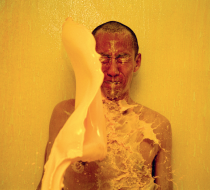Journey of a Yellow Man Favorite
Singaporean artist Lee Wen’s series Journey of a Yellow Man (1992–2012), one of his most famous and long-standing performances, was not simply a personal affront, it was a political affront. At the intersection of Asian art history, critical race theory, and migration and diasporic studies, one is never far (enough away) from the chromatic framing of race and ethnicity: yellow race, yellow peril, yellow face, the forever foreigner. Born in 1957 in colonial Singapore and having grown up in the postcolonial republic, Lee Wen is no stranger to his persona’s explicit, racially marked body. Bald and barefoot, naked except for a pair of briefs and covered completely in bright yellow paint, ‘Yellow Man' spectacularly wandered through the urban spaces of different countries in various situations. The work presages art historian and performance artist Ray Langenbach’s comment on performance art as a way of thinking: ‘“performance art often operates between”: between the state and civil society, between public and private spaces, between “appropriated speech, parody, mimicry, or re-constituted social rituals.”’
First performed at the City of London Polytechnic in April 1992, Journey of a Yellow Man was initially intended to problematise Chinese identity, in particular Lee Wen’s own, and that of many Singaporeans […] who still claim a Chinese identity that is tied to the mainland’. In the United Kingdom, Lee Wen was constantly mistaken for a Chinese national and confronted by ethno-nationalist assumptions about his diasporic identity as a Chinese Singaporean. What does it mean to be predominantly Chinese but yet be in a multicultural society? As Lee Wen states: ‘There is such a thing as diasporas and it does make a difference to one’s identity.’ Migration studies scholars Brenda S. A. Yeoh and Weiqiang Lin would agree, writing that Singapore ‘is at its core a “child of diaspora, (…) a polyglot migrant world constituted by streams of immigrants from China, India, the Malay Archipelago, and other far-flung places”.Singapore was under British rule for 144 years, until 1963 when it merged as part of Malaysia. The political and religious tensions of the 1960s culminated in the violent 1964 race riots between ethnic Chinese and Malay groups. In 1965, Singapore separated from Malaysia and founded itself as an independent republic; since then its government has prioritized maintaining social harmony regardless of race, language or religion.
The importance of the lessons learned from the fraught Journey of a Yellow Man to not only Singapore but also the current global political climate cannot be understated. Yellow Man’s live performances or reappearance through photography and video in major international and local festivals and exhibitions are not only tied to a global history of performance art and Singaporean identity and politics, they also implicate, cringingly so, the present-day resurgence of racism and anti-foreigner sentiments directed towards people from the imaginary ‘Orient’ – South, Southeast, and East Asia, Central Asia and the Middle East. The new historical preoccupation with coerced laborers in the past has yet to dispel race-based discourses about allegedly unassimilable immigrants and refugees from outside one’s own national borders. From Singapore’s stake in the rise of China and the global city’s reencounters with Chinese migration and talks around the Trans-Pacific Partnership (TPP) to the current US president’s divisive foreign policy on racial lines, the specter of Yellow Peril discourse has obviously not receded into the past, in fact, it’s in our face.








